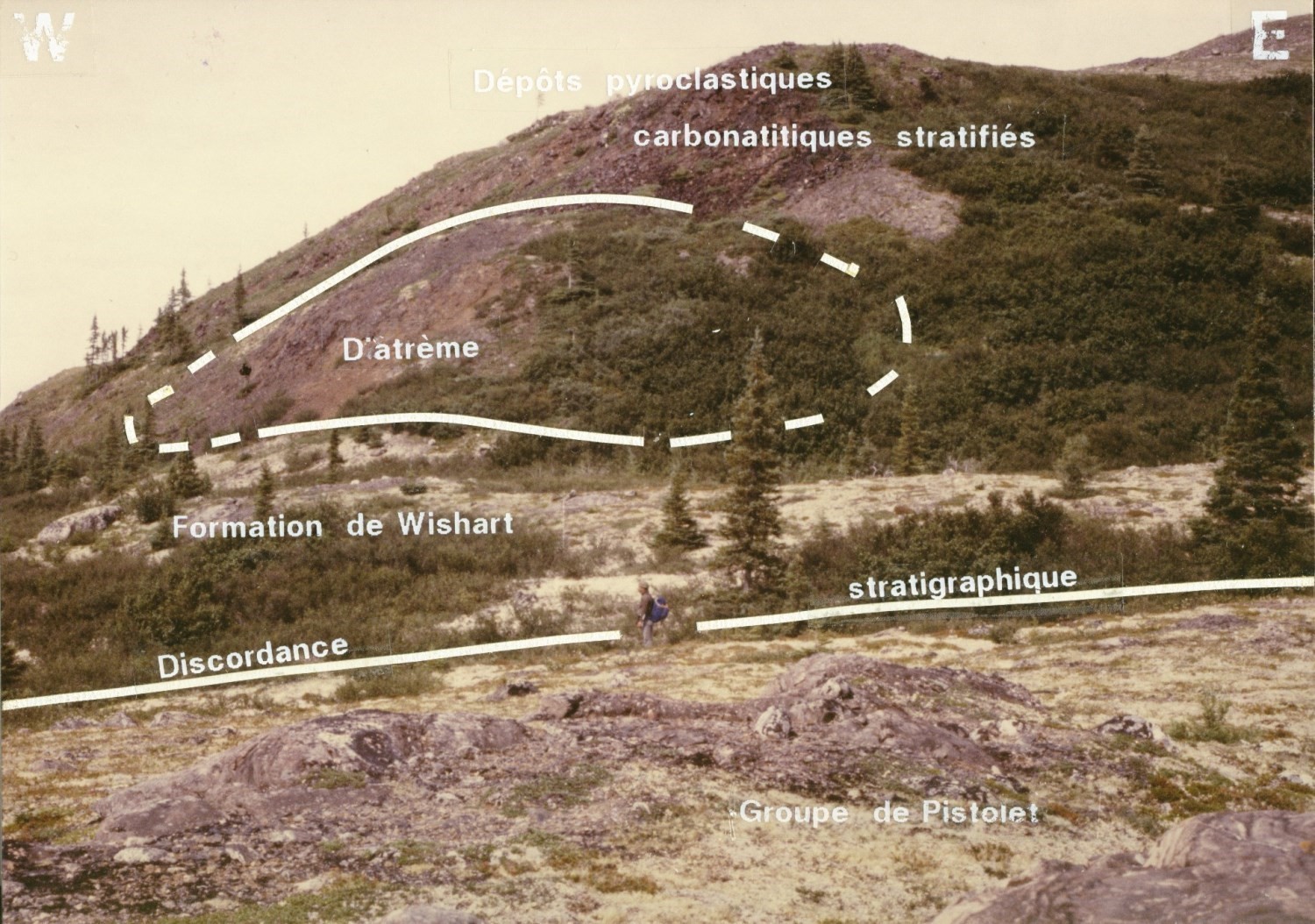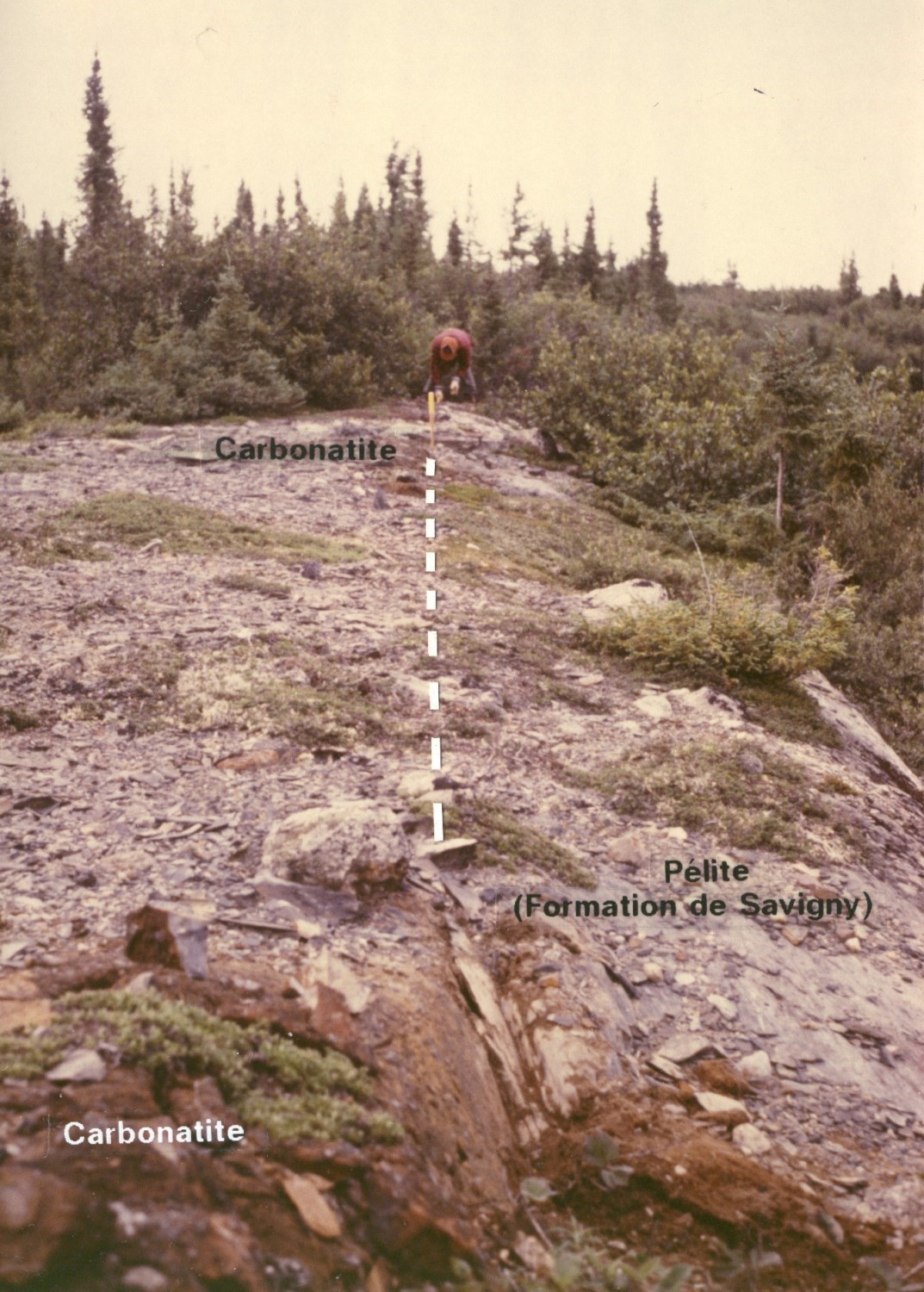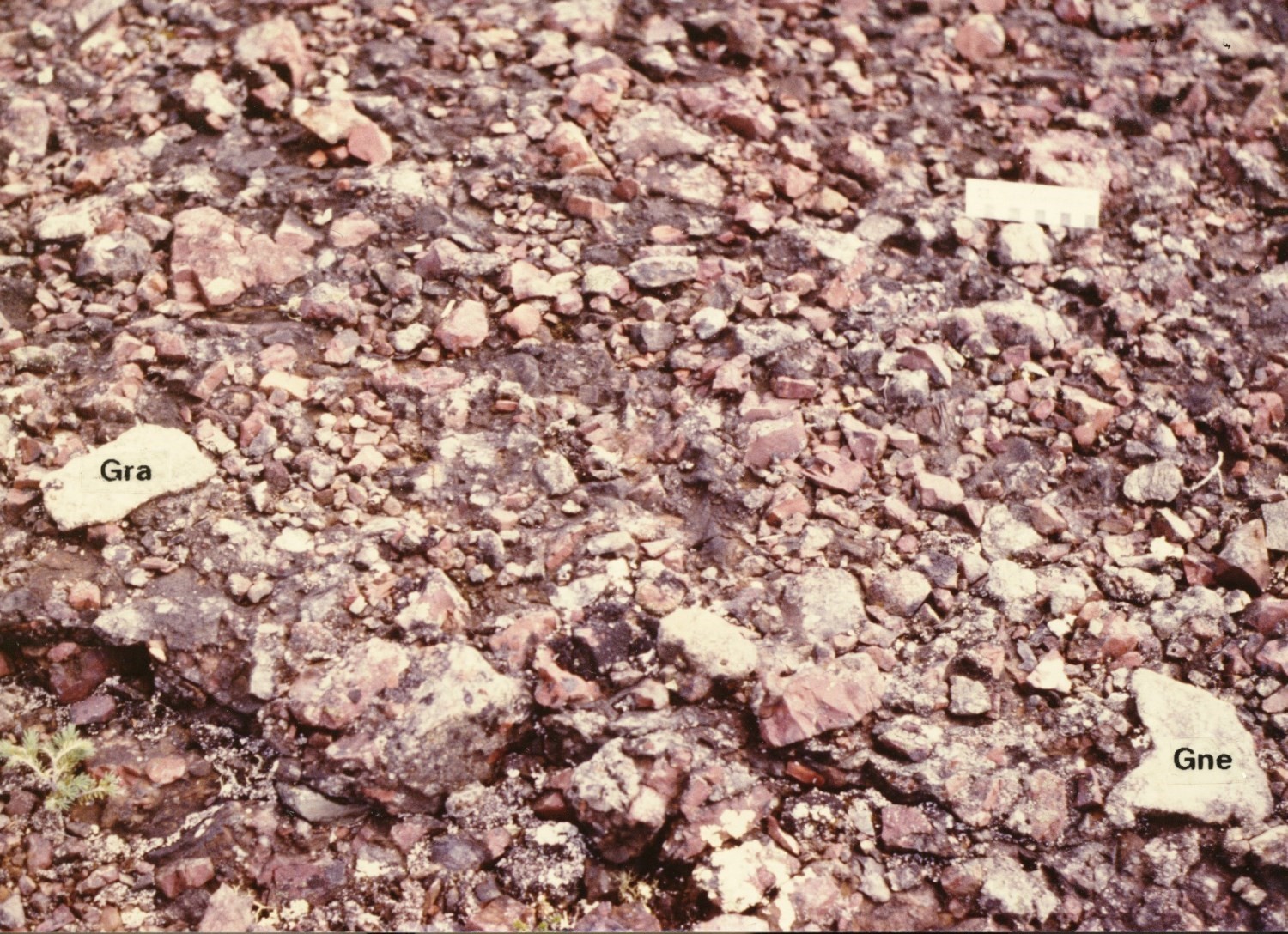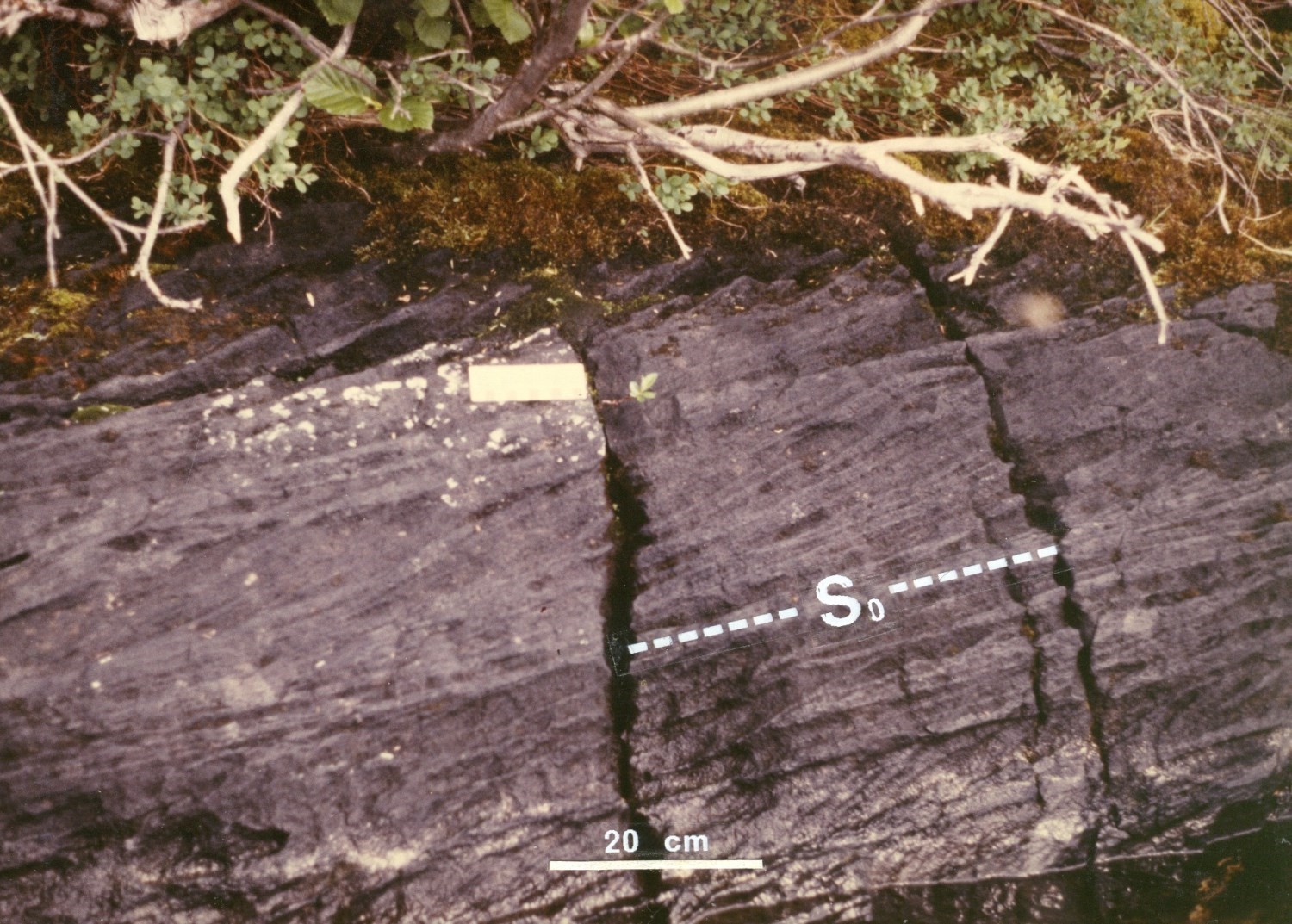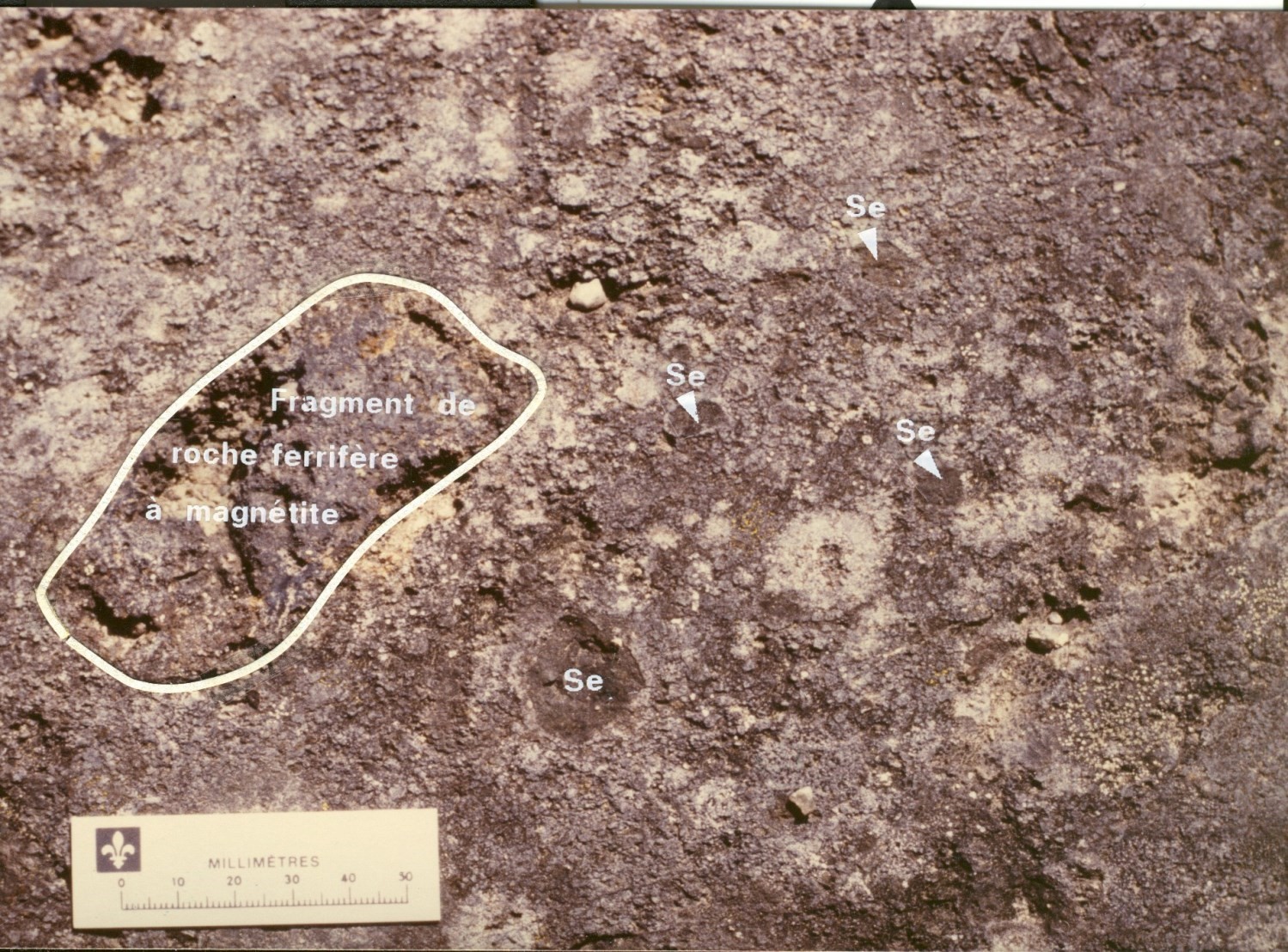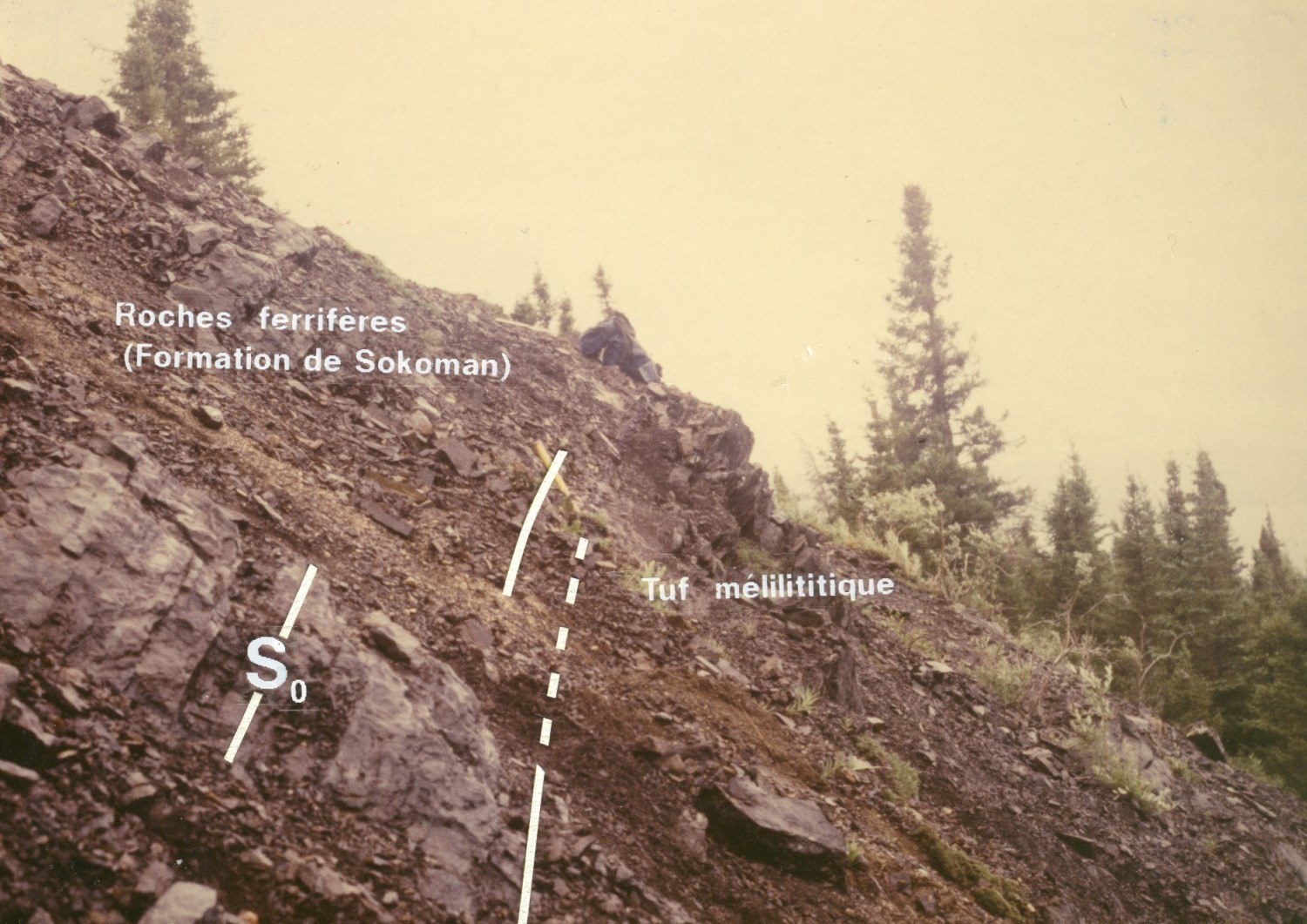
DISCLAIMER: This English version is translated from the original French. In case of any discrepancy, the French version shall prevail.
| Author(s): | Dimroth, 1969, 1970a; Dressler, 1975, 1979; Chevé, 1993 |
| Age: | Paleoproterozoic |
| Stratotype: | None |
| Type area: | Castignon and Hématite lakes area (NTS sheet 24C) |
| Geological province: | Churchill Province |
| Geological subdivision: | New Quebec Orogen (Labrador Trough) / Bérard, Cambrien and Schefferville lithotectonic zones |
| Lithology: | Ultramafic volcanic and intrusive rocks |
| Category: | Lithodemic |
| Rank: | Complex |
| Status: | Formal |
| Use: | Active |
None
Background
The rocks now assigned to the Castignon Volcanic Complex were discovered by E. Dimroth in 1966 during geological mapping of the area west and NW of Castignon Lake (sheet 24C) (Dimroth, 1969, 1978; see history in Dimroth, 1970a). They were subsequently mapped in the area north of latitude 56°30′N (sheet 24C) by Dressler (1973, 1979). Some outcrops of this unit were studied in detail by Chevé (1993).
Geologists have referred to the Castignon Volcanic Complex in different ways at different times:
- « Carbonatite », as volcanic breccia and dyke (Dimroth, 1969);
- « Castignon Lake Complex », as dykes and diatremes of meimechitic and carbonatitic composition (Dimroth, 1970a);
- « Extrusive and intrusive rocks of carbonatitic and kimberlitic chemistry » (Dimroth, 1970b);
- « Intrusive-extrusive complex of ultramafic-alkaline and carbonatitic rocks west of Castignon Lake » (Dimroth, 1978);
- « Castignon Lake Carbonatite Complex » (Chevé, 1993);
- « Castignon Complex » (Clark and Wares, 2004).
Since this unit represents a package of various volcanic and associated intrusive rocks (see below), the complex is here referred to as the « Castignon Volcanic Complex ». This designation is consistent with the use of the term « volcanic complex » as formulated by the North American Stratigraphic Code (NACSN, 1983, 2005; MERQ, 1986).
Description
Dimroth (1970a) described the Castignon Volcanic Complex as a complex of volcanic cones, diatremes and subvolcanic dykes of carbonatitic and meimechitic composition. Dressler (1979) added ultramafic lamprophyre dykes to these lithologies. Chevé (1993) recognized the presence of carbonatitic sills.
According to the terminology of Dimroth (1970a), the term « meimechite » refers to an igneous rock composed of serpentinized olivine ± biotite (probably phlogopite) ± augite altered in a matrix of talc, serpentine and <10% carbonate. The term « meimechite » is equivalent to « olivine melilitite » as used by Dressler (1979) and Chevé (1993). A « carbonate meimechite » refers to the same rock but with 10-30% matrix carbonate, and « meimechitic carbonatite » refers to a rock composed of >50% carbonate in a meimechitic matrix. « Carbonatite » refers to an igneous rock formed of >50% carbonate. All variations between meimechites and carbonatites exist. Dimroth (1970a) refers to rocks of the complex composed of serpentinized olivine-phlogopite-garnet as « kimberlites ».
Most tuffs and all diatremes, including some small dykes, are formed of breccia. The host rock of some diatremes is highly cataclastic. Regionally, dykes are located at the periphery of volcanic cones and diatremes. Fragments of the different igneous breccias are of various compositions. The most abundant and largest fragments come from the surrounding sedimentary rocks. Fragments of iron formation (Sokoman Formation) are common, and most breccias contain small fragments of Archean gneiss. In contrast, fragments from formations stratigraphically above the Sokoman Formation are absent.
The chemical composition of the rocks of the complex shows all the variations between carbonatites and alkaline ultramafic rocks (meimechites). These rocks belong to a series enriched in Al2O3, TiO2, CaO, P2O5, CO2, H2O and F with a low Mg/Fe ratio. They chemically resemble kimberlite, but with abnormally high total iron contents and abnormally low MgO+CaO contents for this group (Dimroth, 1970a, 1978). According to Chevé (1993), the geochemistry of massive rocks of the complex (i.e. homogeneous melilititic rocks, carbonatites, micaceous ultramafics, serpentinized ultramafics and lamprophyres) seems to indicate that they are related to ultramafic lamprophyres (aillikites and alnoites) rather than kimberlites. Alkaline element (sodium and potassium) contents are generally very low (Dimroth, 1970a; Chevé, 1993). According to Dimroth (1970a, 1978), the highly altered lithologies have undergone dealkalization of deuteric origin. Chevé (1993), on the other hand, did not comment on the possibility of post-crystallization alkali loss. In this sense, it is noted that the host rocks of the complex are only slightly fenitized (Dimroth, 1970a). Rare earth element profiles normalized to chondrites indicate a marked enrichment of light rare earths relative to heavy rare earths, and spectra that correspond fairly well to those of kimberlites (Chevé, 1993). Taking into account all his chemical results, Chevé (1993) notes that, with the exception of carbonatites, rocks of the complex are closer to ultramafic lamprophyres than to kimberlites. As for carbonatites, Dimroth (1970a) notes that these rocks are considerably less rich in Sr, Ba and Nb than average carbonatite.
For Dimroth (1970a), the Castignon Volcanic Complex represents different sections through highly explosive volcanic systems that feature feeder dykes, diatremes and volcanic cones. During its ascent through the crust, the magma of the complex would have undergone differentiation by unmixing of immiscible liquids. According to Dimroth (1970a), the separation of two immiscible liquids at great depth is at the origin of carbonate meimechites (olivine melilitites) and phlogopite carbonatites. The former mainly take the form of sills, dykes and tuffs, while the latter form diatremes and dykes. Ankerite carbonatites are thought to represent subvolcanic intrusions, while meimechitic lapilli tuffs (olivine melilititic tuffs) and calcite carbonatites are thought to have been emplaced at or near the surface. The formation of tuffaceous breccias in the complex is thought to be generated by fluidization of a gas-solid system enriched in H2O and CO2. Fluorite (CaF2) appears only in the most differentiated magmas. Dimroth (1970a) proposes that the composition of the primitive magma at the origin of the complex corresponds to that of a carbonate kimberlite. Chevé (1993, p. 77), on the other hand, concludes that « rocks other than carbonatites have affiliation with the ultramafic lamprophyre branch, not the kimberlite branch. »
Dimroth (1970a) considers the volcanic activity to be postorogenic. In contrast, Dressler (1979), supported by Chevé (1993), argues that volcanic activity was synchronous with the deposition of the upper part of the Sokoman Formation. Chevé (1993) agrees with Dressler (1979) that a period of deformation (D1) of relatively low intensity affected pre-Wishart rocks (i.e. rocks of the first volcano-sedimentary cycle) and that this period represents the first pulses of Hudsonian Orogenesis in the Labrador Trough. Such deformation would have been the cause of open folding and tectonic cleavage in sedimentary rocks of the Savigny Formation west of Castignon Lake, as well as in some fragments of the Savigny Formation embedded in diatreme breccias. The main deformation of the orogeny, which is associated with major thrust fault and fold systems (D2), would have affected both volcano-sedimentary cycles of the Trough, including rocks of the Castignon Volcanic Complex.
Regarding the economic potential of the Castignon Volcanic Complex, Clark and Wares (2004, p. 111) note that: « No mineral concentrations of economic importance were reported by Chevé (1993) in the Castignon Volcanic Complex. However, he mentioned the local presence of 3% sulphides in melilititic rocks, mainly pyrite and secondary chalcopyrite and pyrrhotite. Chevé (1993) considers the potential of the complex for PGE or gold deposits to be low. He also considers that the lithochemical affiliation of the complex with ultramafic lamprophyres decreases its diamond potential. Dimroth (1978), for one, noted that the ankeritic composition of the Castignon Carbonatite Complex is not prospective for Nb or REE deposits. However, he points out the presence of apatite and fluorite in an intrusion just west of Brèche lake (20 km east of Cambrien Lake). Traces of Nb were detected at this mineralized site (Lac Savigny site). »
During mapping at scale 1:50 000, Dimroth (1978) divided rocks of the Castignon Volcanic Complex according to their lithological composition and disregarding their style of emplacement. Also working at scale 1:50 000, Dressler (1979) constructed a legend based on both lithologies and style of emplacement. Chevé (1993) also opted for a classification combining lithological characteristics and style of emplacement. The classification adopted here represents a synthesis of these different legends.
Castignon Volcanic Complex, Undivided (pPcas): Carbonatite, Olivine Melilitite as Tuff or Sill, Meimechite
This unit includes all the lithofacies forming the Castignon Volcanic Complex.
Castignon Volcanic Complex 1 (pPcas1): Phlogopite Carbonatite as Dyke, Pipe or Sill; May Contain Up to 10% Heterolithic Enclaves
This unit groups the following lithologies: 1) phlogopite-olivine carbonatite; 2) ankerite carbonatite; 3) fluorite-apatite carbonatite; 4) flow-textured carbonatite; and 5) carbonate-quartz vein (Dimroth, 1970a). Smaller dykes and diatremes may have a porphyritic texture in places. Phlogopite, ankerite, magnetite and olivine phenocrysts are hosted in a very fine-grained serpentine-talc-ankerite matrix.
Phlogopite-olivine carbonatite commonly forms deep level dykes in addition to some small diatremes. The rock contains phlogopite phenocrysts or large poikilitic crystals and serpentinized olivine phenocrysts hosted in a matrix of ankerite, chlorite, serpentine and iron oxides (Dimroth, 1970a, 1978; Chevé, 1993). Ankerite carbonatite contains millimetric ankerite phenocrysts in a very fine-grained matrix. Apatite-fluorite carbonatite contains ankerite phenocrysts 1 to 2 cm in diameter and apatite prisms up to 5 mm long, in a fine-grained ankerite-iron oxide matrix. Fluorite is interstitial. Flow-textured carbonatite composed of carbonate (with or without chlorite-serpentine aggregates) has millimetric to centimetric banding parallel to intrusive contacts.
Castignon Volcanic Complex 2 (pPcas2): Carbonatite as Heterolithic Diatreme Breccia, Pyroclastic Breccia, Lapilli and Block Tuff and Tuff
This unit includes heterolithic diatreme breccia, pyroclastic breccia, lapilli and block tuff, and tuff, all of carbonatitic composition (Dimroth, 1970a; Chevé, 1993). These rocks represent the upper parts of volcanic systems, such as volcanic cones. The volcanic cone located SW of Hématite Lake consists, at the base, of carbonatitic tuff overlain by heterolithic pyroclastic breccia (Chevé, 1993). Most of the core of the volcanic structure is composed of meimechitic lapilli tuff (Dimroth, 1970a). The majority of the fragments in the heterolithic breccia layers are derived from the host rock. The matrix is composed of calcite at high levels in the volcanic systems; however, it is composed of carbonatite/meichecite at deep levels (Dimroth, 1970a).
Castignon Volcanic Complex 3 (pPcas3): Olivine Melilitite (Meimechite) as Tuff or Sill
Olivine melilitite (meimechite) is intrusive or extrusive. Chevé (1993) observed that melilititic tuff in the Hématite Lake area (sheets 24C07 and 24C10) is generally conformable with stratification of the surrounding Sokoman Formation. Lapilli tuff of this composition forms the core of a volcanic cone located SW of Hématite Lake (Dimroth, 1970a; Chevé, 1993). A few minor layers of carbonatitic tuff occur locally in melilititic tuff (Chevé, 1993). As indicated by drilling, the thickness of melilititic tuff layers and melilititic sills emplaced in the upper part of the Sokoman Formation near Hématite Lake varies from 15 to 95 m (Neal et al., 1977).
Dressler (1979, p. 39) describes the petrography of olivine melilititic tuff as follows: « Melilititic rocks are composed of a compact, fine-grained mass of serpentine and opaque minerals, lapillis cemented by delicate green serpentine, or lapillis cemented by variable amounts of calcite. Lapillis are composed of euhedral or subhedral olivine, serpentinized or, in places, carbonatized [sic], and surrounded by melilite laths, opaque minerals or some carbonate. Melilite laths are replaced either by carbonate or, more commonly, by colourless chlorite […] These were indeed originally melilites and the rock is therefore correctly called olivine melilitite. »
Castignon Volcanic Complex 4 (pPcas4): Ultramafic Lamprophyre as Chimney or Dyke
The ultramafic lamprophyre unit occurs as pipes or dykes. Two N-S oriented ultramafic lamprophyre dykes outcrop to the SW of Canichico Lake (sheet 24C10) (Dressler, 1979). Dykes intruded in dolomite beds of the Uvé Formation and iron formation of the Sokoman Formation. In the same area, a small ultramafic lamprophyre pipe ~20 m in diameter intruded into mudstone of the Ruth Formation. Dressler (1979) also mentioned an outcrop of metamorphosed lamprophyre in the eastern belt of the Trough.
Lamprophyre dykes are fine grained and porphyritic. The rock is composed of olivine (completely serpentinized), poikilitic phlogopite, garnet (andradite), calcite and opaque minerals (magnetite and sulphides). Olivine phenocrysts exhibit a preferential orientation defining a fluidal texture. In the form of a chimney, porphyritic lamprophyre is composed of olivine phenocrysts altered to serpentine ± talc ± tremolite and chloritized pyroxene, all in a fine-grained matrix of spherulitic garnet (andradite), phlogopite, apatite and opaque minerals (magnetite and sulphides). Olivine and pyroxene crystals have a fluidal texture.
Thickness and Distribution
The Castignon Volcanic Complex occurs only in the Labrador Trough where it forms numerous map areas distributed between latitudes 56°05′N and 57°04′N, a distance of 100 km (sheets 24C and 24F). The areas are located within the autochthonous-parautochthonous Bérard and Cambrien lithotectonic zones as well as within the allochthonous Schefferville Lithotectonic Zone, as defined by Clark and Wares (2004).
Dating
Dating of a carbonatite-associated lamprophyre from a volcanic neck intruding into sedimentary rocks the Ruth Formation (underlying the Sokoman Formation) gave a K-Ar age of 1873 ±53 Ma (Dressler, 1975, 1979). Chevé and Machado (1988) obtained a concordant U-Pb age of 1880 ±2 Ma for a zircon megacrystal from a fluorite carbonatite feeder dyke located at their locality 16 (Chevé, 1993), west of Castignon Lake. They interpreted this result as the crystallization age of the dyke. This date is also consistent with the age of the Sokoman Formation in this area.
| Isotopic System | Mineral | Crystallization Age (Ma) | (+) | (-) | Reference(s) |
| K-Ar | Total rock | 1873 | 53 | 53 | Dressler, 1975 |
| U-Pb | Zircon | 1880 | 2 | 2 | Chevé and Machado, 1988 |
Stratigraphic Relationship(s)
Dimroth (1969, 1970a, 1970b, 1978) assigned a post-orogenic age to this unit based on the following considerations: 1) breccias of the Castignon Volcanic Complex contain slate fragments of the Savigny Formation; 2) undeformed and unmetamorphosed carbonatitic dykes intruded along the slate cleavage into the host rocks; and, 3) diatremes cut folds and are generally located in anticlines. However, he acknowledges that some diatremes intruding at more superficial levels were highly affected by faults (Dimroth, 1978).
Dressler (1975, 1979) reports that, in addition to the 1873 ±53 Ma age of the lamprophyre associated with carbonatites: 1) olivine melilititic tuff is interbedded with iron-bearing units of the Sokoman Formation; 2) no carbonatitic rocks are observed in sedimentary rocks of the Menihek Formation (stratigraphically overlying the Sokoman Formation) in the area he mapped; 3) some melilititic tuffs show evidence of tectonic deformation; 4) olivine melilititic rocks occur at various stratigraphic levels in the upper part of the Sokoman Formation; and 5) a lamprophyre dyke exposed in the eastern part of the Labrador Trough is deformed and metamorphosed. He inferred that these rocks predate the Menihek Formation and are synchronous with the emplacement of the upper part of the Sokoman Formation. Dressler (1979) explained the presence of slate fragments in carbonatite breccias by a mild deformation episode of pre-Wishart age, i.e. between the deposition of first- and second-cycle rocks. The possible existence of such deformation had already been mentioned by Dimroth et al. (1970) and Le Gallais and Lavoie (1982).
Chevé (1993) presents several field evidences indicating that this unit is contemporaneous with the deposition of the Sokoman Formation: 1) melilititic tuff layers are conformation with Sokoman Formation strata; 2) carbonatitic volcaniclastic beds are visible in the Sokoman Formation; 3) slate fragments originating from the Savigny Formation (first cycle) are embedded in diatreme breccia and possess tectonic cleavage; and 4) some units of the complex intruded along a tectonic plane predating the Sokoman Formation.
Dimroth (1970a, 1978) describes carbonatitic diatremes that, in some places, were emplaced in the brecciated Savigny Formation. This author observed carbonatitic to meimechitic dykes, generally oriented N-S, which cut the Savigny Formation. Chevé (1993) observed that some of these « dykes » are in fact conformable to stratification of the host rock, which makes them rather like sills. According to Dimroth (1970a), the southernmost dykes were emplaced at relatively deep stratigraphic levels in the volcanic systems.
West of Hématite Lake (sheet 24C10), Dressler (1979) reports the presence of two olivine melilititic tuff beds in iron-bearing units of the Sokoman Formation. Dressler (1979) pointed out that, in the Hématite Lake area, olivine melilititic rocks occur at various stratigraphic levels in the upper part of the Sokoman Formation. However, rocks of the complex have never been observed in the Menihek Formation or in other units stratigraphically overlying the Sokoman Formation. Dressler (1979) and Chevé (1993) therefore believe that emplacement of the complex is contemporaneous with the deposition of the Sokoman Formation.
Paleontology
Does not apply.
References
Publications Available Through SIGÉOM Examine
CHEVE, S. 1993. CADRE GEOLOGIQUE DU COMPLEXE CARBONATIQUE DU LAC CASTIGNON – FOSSE DU LABRADOR. MRN. MB 93-64, 100 pages and 1 plan.
CLARK, T., WARES, R. 2004. SYNTHESE LITHOTECTONIQUE ET METALLOGENIQUE DE L’OROGENE DU NOUVEAU-QUEBEC (FOSSE DU LABRADOR). MRNFP. MM 2004-01, 182 pages and 1 plan.
DIMROTH, E. 1966. GEOLOGIE DE LA REGION DU LAC DUNPHY, TERRITOIRE DU NOUVEAU-QUEBEC. MRN. RP 557, 24 pages and 1 plan.
DIMROTH, E. 1966. PRELIMINARY REPORT, GEOLOGY OF DUNPHY LAKE AREA, NEW QUEBEC TERRITORY. MRN. RP 557(A), 21 pages and 1 plan.
DIMROTH, E. 1969. GEOLOGIE DE LA REGION DU LAC CASTIGNON, TERRITOIRE DU NOUVEAU-QUEBEC. MRN. RP 571, 62 pages and 7 plans.
DIMROTH, E. 1969. PRELIMINARY REPORT, GEOLOGY OF THE CASTIGNON LAKE AREA, NEW QUEBEC TERRITORY. MRN. RP 571(A), 58 pages and 7 plans.
DIMROTH, E. 1978. REGION DE LA FOSSE DU LABRADOR ENTRE LES LATITUDES 54° 30′ ET 56° 30′. MRN. RG 193, 417 pages and 16 plans.
DRESSLER, B. 1973. GEOLOGIE DE LA REGION DU LAC PATU, TERRITOIRE DU NOUVEAU-QUEBEC. MRN. RP 603, 26 pages and 1 plan.
DRESSLER, B., CIESIELSKI, A. 1979. REGION DE LA FOSSE DU LABRADOR. MRN. RG 195, 136 pages and 14 plans.
MERQ. 1986. CODE STRATIGRAPHIQUE NORD-AMERICAIN. DV 86-02, 76 pages.
NEAL, H.E. AND ASSOCIATES LTD., 1977. Preliminary investigation 1975-1976 December lake iron property, Quebec Ungava Mining Company. Rapport statutaire soumis au gouvernement du Québec. GM 33386, 363 pages and 37 plans.
Other Publications
CHEVÉ, S.R., MACHADO, N. 1988. Reinvestigation of the Castignon Lake carbonatite complex, Labrador Trough, New Québec. Joint Annual Meeting of the Geological Association of Canada and the Mineralogical Association of Canada, St. John’s, Newfoundland; Program with Abstracts, volume 13, page 20.
DIMROTH, E. 1970a. Meimechites and carbonatites of the Castignon Lake Complex, New Quebec. Neues Jahrbuch für Mineralogie, Abhandlungen; volume 112, pages 239-278.
DIMROTH, E. 1970b. Evolution of the Labrador Geosyncline. Geological Society of America Bulletin; volume 81, pages 2717-2742. doi.org/10.1130/0016-7606(1970)81[2717:EOTLG]2.0.CO;2
DIMROTH, E., BARAGAR, W.R.A., BERGERON, R., JACKSON, G.D. 1970. The filling of the Circum-Ungava geosyncline. In Symposium on Basins and Geosynclines of the Canadian Shield (A.J. Baer, editor). Geological Survey of Canada; Paper 70-40, pages 45-172. doi.org/10.4095/124922
DRESSLER, B. 1975. Lamprophyres of the north-central Labrador Trough, Quebec, Canada. Neues Jahrbuch für Mineralogie, Monatshefte; volume 6, pages 268-280.
LE GALLAIS, C.J., LAVOIE, S. 1982. Basin evolution of the Lower Proterozoic Kaniapiskau Supergroup, central Labrador miogeocline (Trough), Quebec. Bulletin of Canadian Petroleum Geology, volume 30, pages 150-166. bcpg.geoscienceworld.org/content/30/2/150
NORTH AMERICAN COMMISSION OF STRATIGRAPHIC NOMENCLATURE (NACSN). 1983. North American Stratigraphic Code. American Association of Petroleum Geologists Bulletin; volume 67, pages 841-875. archives.datapages.com/data/bulletns/1982-83/data/pg/0067/0005/0800/0841.htm
NORTH AMERICAN COMMISSION OF STRATIGRAPHIC NOMENCLATURE (NACSN). 2005. North American Stratigraphic Code. American Association of Petroleum Geologists Bulletin, volume 89, pages 1547-1591. nacsn.americangeosciences.org/sites/default/files/2018-08/AAPG_Bull-89_NACSN-Code.pdf
Suggested Citation
Ministère de l’Énergie et des Ressources naturelles (MERN). Castignon Volcanic Complex. Quebec Stratigraphic Lexicon. https://gq.mines.gouv.qc.ca/lexique-stratigraphique/province-de-churchill/complexe-de-castignon_en [accessed on Day Month Year].
Contributors
|
First publication |
Thomas Clark, P. Geo., Ph.D. (redaction) Mehdi A. Guemache, P. Geo., Ph.D. (coordination); Charles St-Hilaire, GIT, M.Sc. (critical review); Simon Auclair, P. Geo., M.Sc. (editing); Céline Dupuis, P. Geo., Ph.D. (English version); Yan Carette and André Tremblay (HTML editing). |


